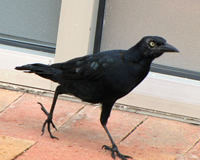Starlings

[audio:starlings.mp3|titles=Starlings Sounds]
Peak Nuisance Period: Any Time of Year
Common Nuisance Situations:
- Nesting in attics, under the eaves, and in soffits and other openings in buildings.
- Where enormous flocks (up to a million starlings) gather, they can be intensely noisy. Their droppings smell bad, and are corrosive and slippery to walk on. Under certain conditions, the droppings can promote the growth of the fungus that causes histoplasmosis, an airborne disease that affects people.
- These “feathered bullets” can cause plane crashes. Starlings travel in large flocks that can collide with a plane, or get sucked into the engine.
- Eat (and contaminate) livestock feed, grains, fruits (grapes, peaches, blueberries, strawberries, figs, apples, cherries), and garbage.
- Take over nesting sites of native songbirds (purple martins, flickers and other woodpeckers, bluebirds) and wood ducks. If nest sites are limited, starlings may severely hurt the populations of these native birds.
- May transfer disease (transmissible gastroenteritis) from one livestock facility to another.
Disease risks: histoplasmosis to people, transmissible gastroenteritis to livestock, especially pigs.
Animal Characteristics
Description: The starling is a dark chunky, muscular bird. It is distinguished from other blackbirds by its short tail and its longer, slender bill. They are approximately eight inches long with long wings and a short squared tail. Starling plumage varies depending on the season. In winter, the bird displays a highly speckled iridescent coat and a dark bill. In summer, the bird’s coat dulls and has far fewer speckles. Starlings are very aggressive and will drive native birds out of their territory, much to the dismay of local bird watchers. Starlings are well noted for their flocking habits. They often gather in the tens of thousands, creating a nuisance when roosting in populated areas.
Diet: They are omnivores. Starlings eat Seeds and fruits (native and cultivated), and insects— especially grubs, which are essential during breeding season. They will gladly feast on every orchard and berry crop. They eat livestock rations, picking out the high-protein supplements mixed into the feed. Starlings often contaminate more than they actually eat. They’ll eat garbage, too.
Habitat: Urban, suburban, and rural areas that offer nest sites (holes in trees, buildings), and foraging areas (parks, lawns, fields, pastures, livestock facilities, dumps).
Breeding: Starlings mate early to mid spring. Eggs are hatched 11-13 days and they typically lay between 4-7 eggs.
Mythbusters: N/A
